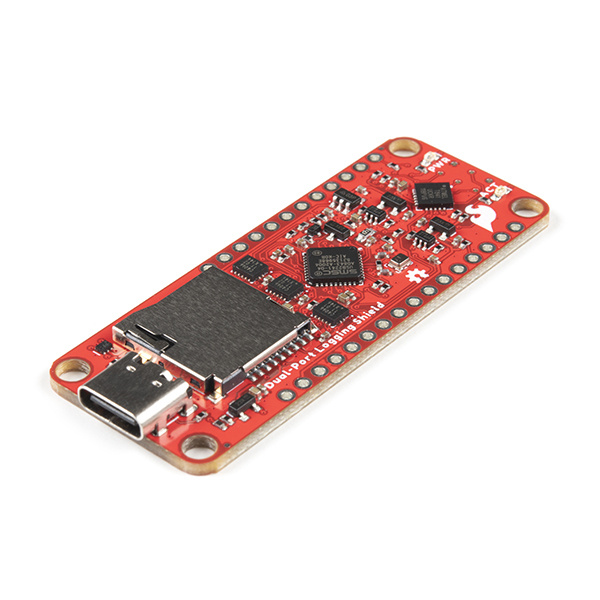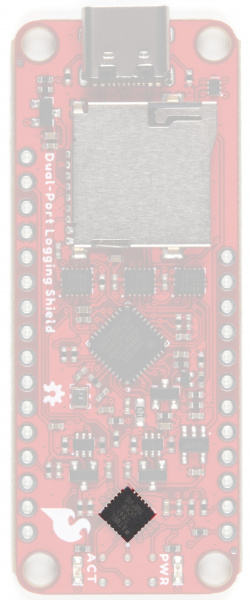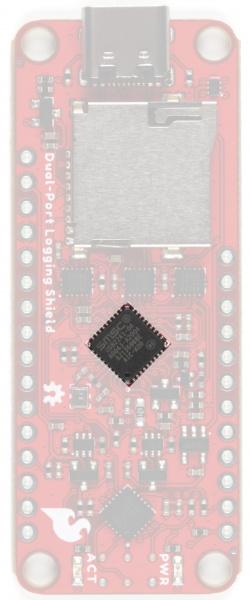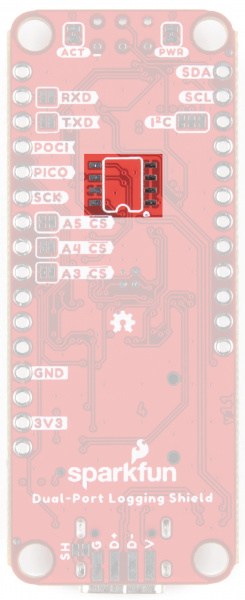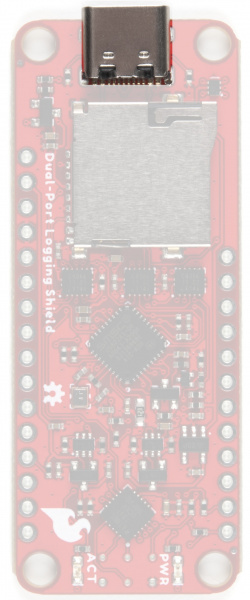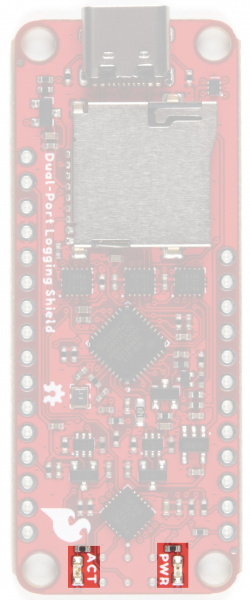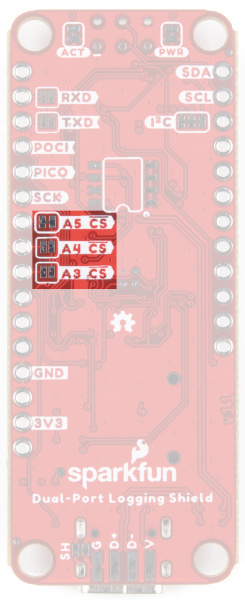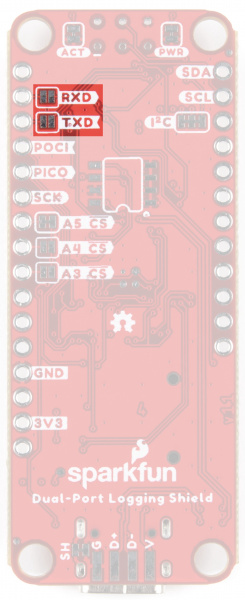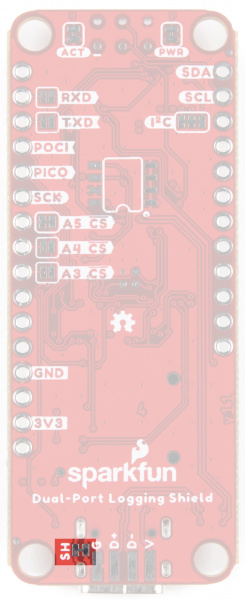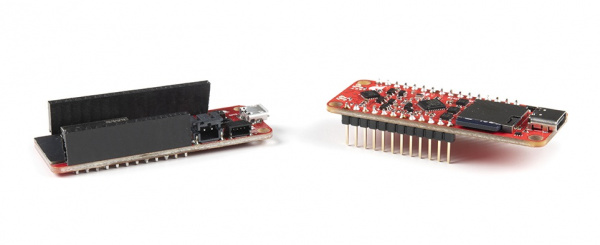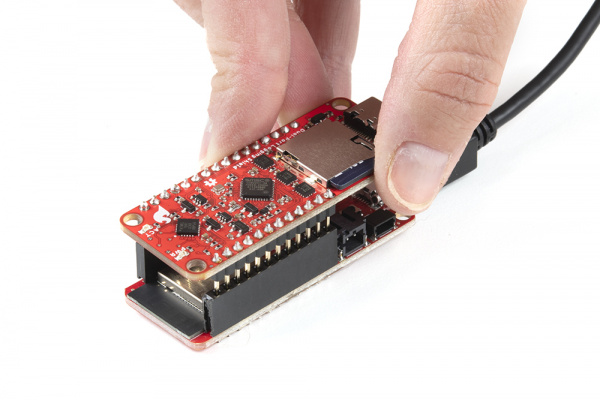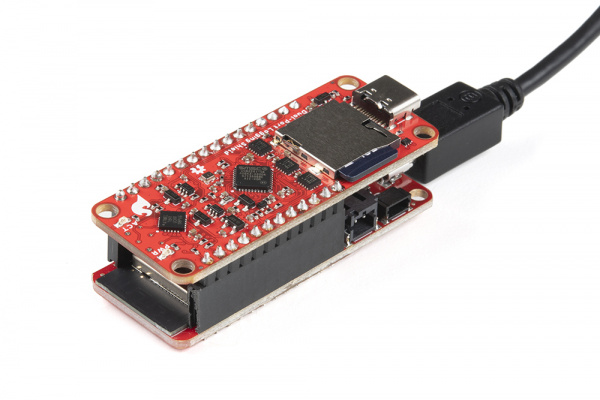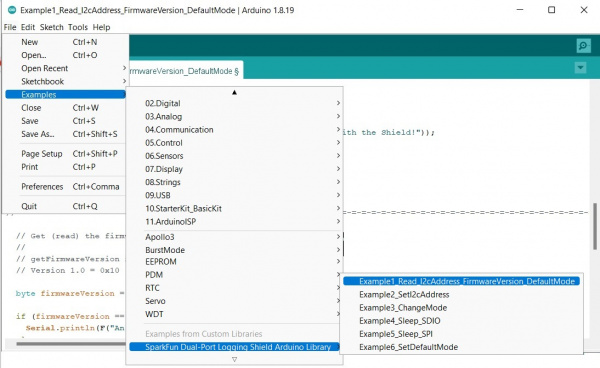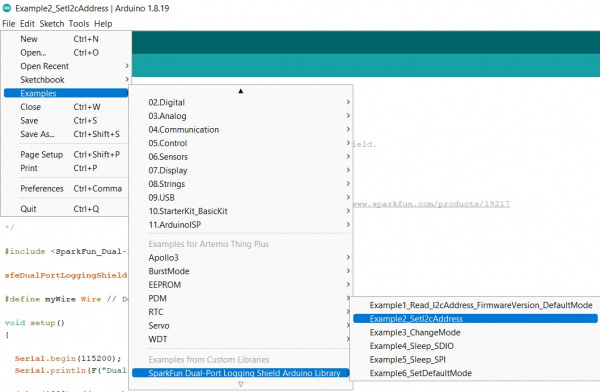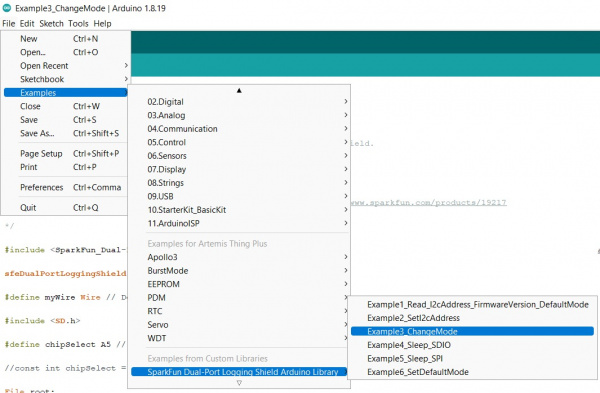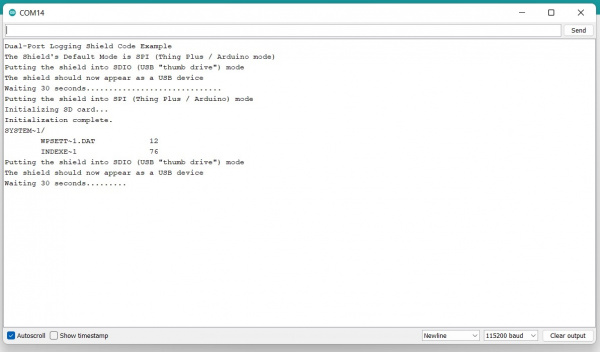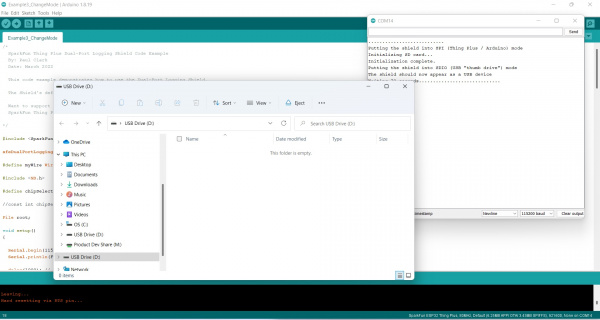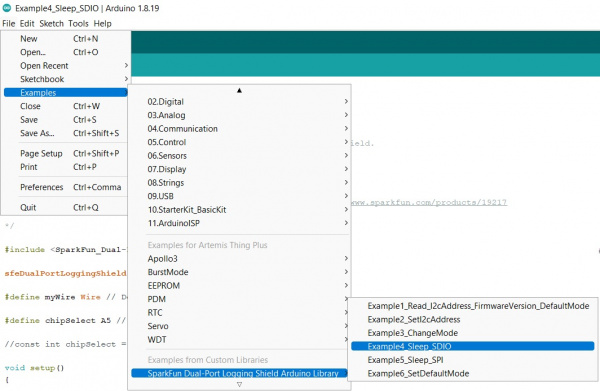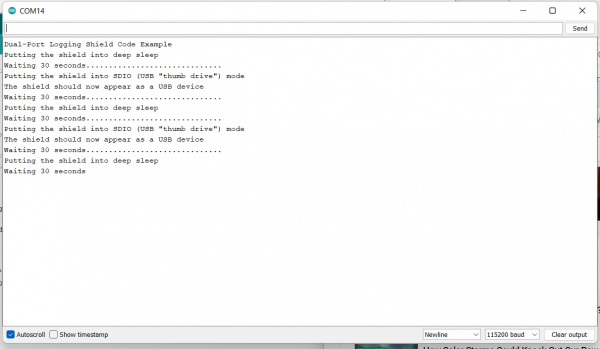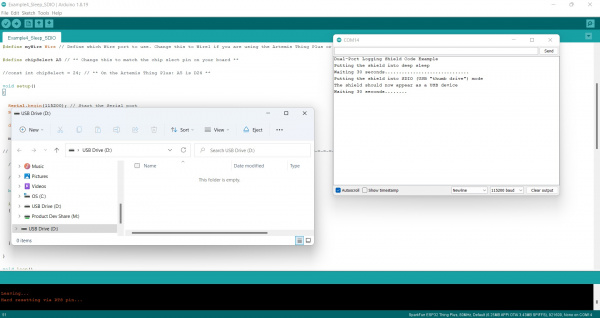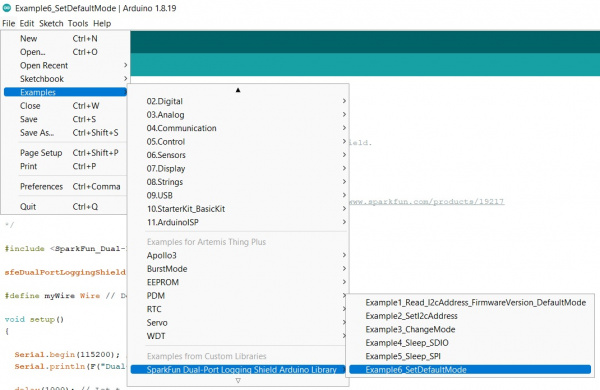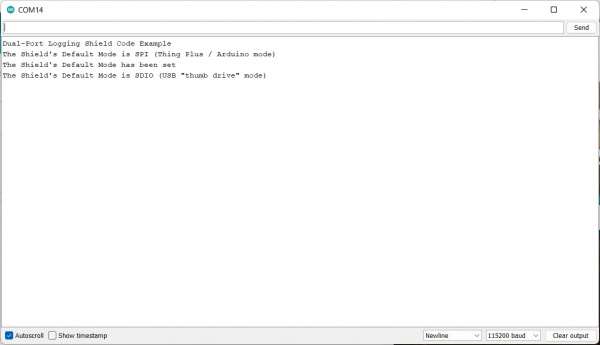Thing Plus Dual-Port Logging Shield Hookup Guide
Introduction
The Thing Plus Dual-Port Logging Shield is a Thing Plus/Feather compatible board that lets you access your microSD card over both SPI and USB-C! It is designed to be mounted on or under one of our Thing Plus boards. You can log data to and read data from your microSD card over SPI as usual, using your favorite Arduino SD library. But you can also connect it to your computer via USB-C and read and write files at up to 35 MBytes/second! The write speed is card-dependent but, in our tests, we've routinely seen write speeds around 20MB/s. No more removing the microSD to read your data!
Required Materials
To follow along with this tutorial, you will need the following materials. You may not need everything though depending on what you have. Add it to your cart, read through the guide, and adjust the cart as necessary.
Suggested Reading
If you aren’t familiar with the following concepts, we recommend checking out these tutorials before continuing.
Voltage, Current, Resistance, and Ohm's Law
Battery Technologies
Alternating Current (AC) vs. Direct Current (DC)
Hardware Overview
ATtiny841
The Dual-Port Logging Shield has an ATtiny841 microcontroller on it to act as an arbiter:
- If you power up your Thing Plus, the ATtiny841 will automatically put the Dual-Port Logging Shield into SPI mode, so your Arduino code can access the microSD card as normal
- If you power the Shield from your computer by connecting it via USB-C, the ATtiny841 will put the Shield into SDIO "thumb drive" mode. Your computer can then read and write data really quickly!
- If you have both your Thing Plus powered up - and have your computer connected - then you can switch between the two modes by giving the ATtiny841 some very simple commands over I2C!
You can configure the ATtiny to automatically default to SPI mode or SDIO "thumb drive" mode if both power sources are powered up simultaneously. It's your choice!
USB2241
The USB224x is a fully integrated, single chip solution capable of ultra high performance operation. Average sustained transfer rates exceeding 35 MB/s are possible if the media and host can support those rates. The USB224 includes provisions to read/write secure media formats.
Programming Footprint
Advanced users can change the shield's USB Vendor ID (VID), Product ID (PID), Manufacturer Name etc. by adding an optional 24C04 (512x8) EEPROM and configuring it with Microchip's USBDM tool.
microSD Card Slot
The USB2241, which provides the USB interface, supports FAT32, exFAT and NTFS on cards up to and including 32GB. Cards larger than 32GB are not supported.
USB-C
While attached to the Thing Plus, you can log data to and read data from your microSD card over SPI as usual. But you can also connect the shield directly to your computer via the USB-C port and read/write files directly.
LEDs
There are two LEDs on the front of the board; PWR and ACT. PWR should be self-explanatory - it is the LED that lights up when there is power to the shield. ACT stands for activity monitor - this shows data movement on the shield in SDIO "thumb drive" mode.
Jumpers
I2C
These split pads are closed by default to enable the shield's I2C pull-up resistors. Please be aware that, with the pull-ups enabled, the shield's VCC will try to back-feed power to the Thing Plus through the pull-ups on both boards. Opening the jumpers will prevent this.
The default (unshifted) I2C address is 0x51 but is programmable via the code.
LEDS
Should you wish to disable either of the LEDs on the front of the board, cut the trace on the appropriate jumper.
Chip Select
By default, the microSD SPI chip select signal is connected to pin A5 on the Thing Plus. If you are already using that pin for something else, you can open the A5 jumper and close A4 or A3 instead.
Serial
The ATtiny841 has a Serial (UART) interface but we only make limited use of it in the standard shield firmware. If you want to, you can connect the ATtiny serial pins to the standard Thing Plus Serial pins by closing the RXD and TXD jumpers. You will then see some diagnostic messages at 9600 baud when the ATtiny powers up. These jumpers are really there for any advanced users who want to write their own firmware for the ATtiny!
SH
By default, the USB-C shield is connected to the shield GND (0V). You can isolate the shield if you want to by opening the SH jumper.
Board Outline
Hardware Hookup
In order to use your Dual Port Logger as a shield, you'll need to solder some headers on. My ESP32 Thing Plus has female headers already soldered on, so for this tutorial, we've used male headers on the Dual Port Logging Shield like so:
Once you've got all your headers properly soldered on, line up the pins and connect your Thing Plus and Shield like so:
Tadaaaa! All ready for programming!
Software Installation
The SparkFun Dual-Port Logging Shield Arduino Library can be downloaded with the Arduino library manager by searching 'SparkFun Dual-Port Logging Shield Arduino Library' or you can grab the zip from here or from the GitHub repository to manually install:
Example 1: Read I2C Address/Firmware Version
Now that we've got our hardware sorted out, let's have a look at some examples.
In this first example, we're just going to report out on our I2C address and Firmware Version.
To start, plug your Thing Plus with its Dual Port Logging Shield into your computer, open a new Arduino sketch, and click "File > Examples > SparkFun Dual-Port Logging Shield Arduino Library > Example1_Read_I2CAddress_FirmwareVersion_DefaultMode".
Choose the correct Board and Port (as seen here):
And then upload the code to your Thing Plus. When you open the Serial Monitor with the correct baud, you should see something like the following:
Example 2: Set I2C Address
Example 2 shows you how to change the I2C address of the shield. Let's bring it up in Arduino:
Make sure you select the correct board and port, and then smash that upload button. Once the code is compiled and uploaded, go ahead an open the Serial Monitor. You should see something like the following:
Example 3: Change Mode
There are different modes available for the Dual Port Logging Shield. Example three shows you how to change between SDIO (thumb drive) and SPI modes!
To start, let's pull up example 3 in Arduino.
Make sure you've chosen the correct board and port (as seen in example 1) and then upload the code to your Thing Plus. When you open the Serial Monitor with the correct baud, you should see something like the following:
Make sure your Dual Port Logger is ALSO plugged in, and when the example runs, you'll see an additional drive pop up like so:
Example 4: Sleep SDIO
In this example, we're going to look at the deep sleep functionality, and like Example 3, this example will also bring up the Dual Port Logging Shield as a drive. Go ahead and bring up example 4 in Arduino:
Make sure you've chosen the correct board and port (as seen in example 1) and then upload the code to your Thing Plus. When you open the Serial Monitor with the correct baud, you should see something like the following:
Make sure your Dual Port Logger is ALSO plugged in, and when the example runs, you'll see an additional drive pop up like so:
Example 5: Sleep SPI
Example 5 shows the Sleep cycle for SPI mode. Bring up the example in Arduino:
Make sure you've chosen the correct board and port (as seen in example 1) and then upload the code to your Thing Plus. When you open the Serial Monitor with the correct baud, you should see something like the following:
Example 6: Set Default Mode
If you run into a snag, setting things back to default is always a good way to go. This example will do just that!
Bring it on up in Arduino:
Make sure you've chosen the correct board and port (as seen in example 1) and then upload the code to your Thing Plus. When you open the Serial Monitor with the correct baud, you should see something like the following:
Troubleshooting
If your product is not working as you expected or you need technical assistance or information, head on over to the SparkFun Technical Assistance page for some initial troubleshooting.
If you don't find what you need there, the SparkFun Forums are a great place to find and ask for help. If this is your first visit, you'll need to create a Forum Account to search product forums and post questions.
Resources and Going Further
Need more information? Check out some of the links below:
Check out these other power related tutorials from SparkFun:
